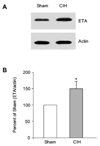Cyclic intermittent hypoxia enhances renal sympathetic response to ICV ET-1 in conscious rats
- PMID: 20227529
- PMCID: PMC2884044
- DOI: 10.1016/j.resp.2010.03.008
Cyclic intermittent hypoxia enhances renal sympathetic response to ICV ET-1 in conscious rats
Abstract
To test the hypothesis that central changes in sympathoregulation might contribute to sympathoexcitation after cyclic intermittent hypoxia (CIH) we exposed male Sprague-Dawley rats to CIH or to room air sham (Sham) for 8h/d for 3 weeks. After completion of the exposure we assessed heart rate, mean arterial pressure and renal sympathetic nerve activity in conscious animals before and after intracerebroventricular (i.c.v.) administration of endothelin-1 (ET-1, 3 pmol). CIH-exposed animals had a significantly greater sympathetic response to ET-1 than did Sham-exposed animals (CIH 137.8+/-15.6% of baseline; Sham 112.2+/-10.0% of baseline; CIH vs. Sham, P=0.0373). This enhanced sympathetic response to i.c.v. ET-1 was associated with greater expression of endothelin receptor A (ETA) protein in the subfornical organs of CIH-exposed relative to Sham-exposed rats. We conclude that 3-week CIH exposure enhances central ET-1 receptor expression and the sympathetic response to i.c.v. ET-1 suggesting central endothelin may contribute to the sympathetic and hemodynamic response to cyclic intermittent hypoxia.
(c) 2010 Elsevier B.V. All rights reserved.
Figures




Similar articles
-
Sympathetic response to chemostimulation in conscious rats exposed to chronic intermittent hypoxia.Respir Physiol Neurobiol. 2009 Apr 30;166(2):102-6. doi: 10.1016/j.resp.2009.02.010. Epub 2009 Mar 3. Respir Physiol Neurobiol. 2009. PMID: 19429526
-
[Bosentan ameliorates hypertension in rats exposed to chronic intermittent hypoxia through inhibiting renal sympathetic nerve activity].Sheng Li Xue Bao. 2018 Aug 25;70(4):354-360. Sheng Li Xue Bao. 2018. PMID: 30112560 Chinese.
-
Chronic intermittent hypoxia increases sympathetic control of blood pressure: role of neuronal activity in the hypothalamic paraventricular nucleus.Am J Physiol Heart Circ Physiol. 2013 Dec;305(12):H1772-80. doi: 10.1152/ajpheart.00592.2013. Epub 2013 Oct 4. Am J Physiol Heart Circ Physiol. 2013. PMID: 24097432 Free PMC article.
-
Sympathoexcitation and arterial hypertension associated with obstructive sleep apnea and cyclic intermittent hypoxia.J Appl Physiol (1985). 2015 Dec 15;119(12):1449-54. doi: 10.1152/japplphysiol.00315.2015. Epub 2015 Aug 6. J Appl Physiol (1985). 2015. PMID: 26251511 Review.
-
Sex differences in the respiratory-sympathetic coupling in rats exposed to chronic intermittent hypoxia.Respir Physiol Neurobiol. 2018 Oct;256:109-118. doi: 10.1016/j.resp.2017.09.003. Epub 2017 Sep 8. Respir Physiol Neurobiol. 2018. PMID: 28893610 Review.
Cited by
-
Is Aberrant Reno-Renal Reflex Control of Blood Pressure a Contributor to Chronic Intermittent Hypoxia-Induced Hypertension?Front Physiol. 2019 Apr 24;10:465. doi: 10.3389/fphys.2019.00465. eCollection 2019. Front Physiol. 2019. PMID: 31105584 Free PMC article. Review.
-
Molecular mechanisms of chronic intermittent hypoxia and hypertension.Crit Rev Biomed Eng. 2012;40(4):265-78. doi: 10.1615/critrevbiomedeng.v40.i4.30. Crit Rev Biomed Eng. 2012. PMID: 23140119 Free PMC article. Review.
-
Long-Term High-Altitude Hypoxia and Alpha Adrenoceptor-Dependent Pulmonary Arterial Contractions in Fetal and Adult Sheep.Front Physiol. 2019 Aug 28;10:1032. doi: 10.3389/fphys.2019.01032. eCollection 2019. Front Physiol. 2019. PMID: 31555139 Free PMC article.
References
-
- Bao G, Metrevelli N, Li R, Taylor A, Fletcher EC. Blood pressure response to chronic episodic hypoxia: role of the sympathetic nervous system. J Appl Physiol. 1997;83:95–101. - PubMed
-
- Brooks D, Horner RL, Kimoff RJ, Kozar LF, Render-Texeira CL, Phillipson EA. Effect of obstructive sleep apnea versus sleep fragmentation on responses to airway occlusion. Am. J. Respir. Crit. Care Med. 1997a;155:1609–1617. - PubMed
-
- Brooks VL, Scrogin KE, McKeogh DF. The interaction of angiotensin II and osmolality in the generation of sympathetic tone during changes in dietary salt intake: an hypothesis. Ann NY Acad Sci. 2001;940:380–394. - PubMed
-
- Campese VM, Ye S, Zhong H. Downregulation of neuronal nitric oxide synthase and interleukin-1b mediates angiotensin II-dependent stimulation of sympathetic nerve activity. Hypertension. 2002;39:519–524. - PubMed
Publication types
MeSH terms
Substances
Grants and funding
LinkOut - more resources
Full Text Sources

